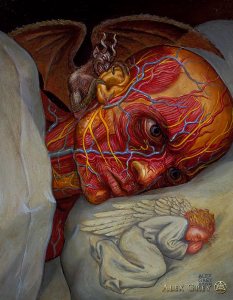The Awake Craniotomy
Notes from Gupta/Gelb ch 20 “Perioperative Management of Awake Craniotomy” and Oxford Handbook of Anesthesia
Indications
-Tumor or lesion near eloquent areas of brain
-steroetactic and DBS for Parkinson’s
-epilepsy surgery
Background
-either local + sedation, or GA with i/o wake up, or combination of sedation + awake
Preop
-good rapport with patient essential
-determine if patient will tolerate, mentally, lying flat for long period (especially challenging in children)
-obesity, reflux and highly vascular tumors may also caution against
Cortical Mapping
-Cortical mapping = electrical stim to recognize sensitive areas, can ID motor, sensory, speech
-despite mapping, many surgeons prefer fully awake to ensure no neurodeficits post op
-intraop ECoG (electrocorticography) may be used to ID epileptogenic focus
I/O Management
-routine a-line, foley (if long)
-positioning in comfort is key, head best positioned with 3 pin fixator under local (minimize movement, max airway control)
-always have access to airway
-Multiple techniques: local, local + sedation, asleep awake asleep with GA and I/O wake up (for more complex/extensive)
-Skin, scalp, pericranium and periosteum of skull –> extensive sensory innervation; use field block or scalp block (see prior post). Dura has extensive innervation, so anesthestize nerve trunk near middle meningeal and edges of cranium (see scalp block post).
-Precedex and Remi, both good choices for short-acting pain control and sedation without profound respiratory depression (especially precedex).
-Anti-emetics important –> especially for temporal lobe epilepsy surgery –> highly emotogenic.
Airway Control
-many techniques, from spon vent without devices to ETT and LMA.
-Risk of coughing during removal of LMA or ETT when dura open!
-ETT/LMA allow more precise monitroing of ETCO2
-Can be difficult to reintubate, and ETT makes assessing verbal responses difficult/impossible
-Alternative: Soft nosopharyngeal airway (with 25% cocaine paste as per Gupta/Gelb), can remain in place throughout procedure and monitor ETCO2, oxygen through other nostril. Risky in obese patients.
I/O Problems
– Uncooperative patient, cardiovascular (htn, hypotension, tachy), excessive sedation–>increased PaCO2–>Edema, resp depression, loss of airway, brain swelling, seizures(tx with propofol 20-40mg, or iced saline spray to cortex), pain, Local toxicity
-Patients with mass effect tumors -> most at risk for PaCO2 related brain swelling
